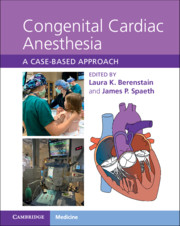Book contents
- Congenital Cardiac Anesthesia
- Congenital Cardiac Anesthesia
- Copyright page
- Dedication
- Contents
- Contributors
- Introduction
- Chapter 1 A Congenital Heart Disease Primer
- Section 1 Left-to-Right Shunts
- Section 2 Right-Sided Obstructive Lesions
- Section 3 Left-Sided Obstructive Lesions
- Section 4 Complex Mixing Lesions
- Section 5 Single-Ventricle Physiology
- Chapter 26 Stage I Palliation, Hypoplastic Left Heart Syndrome
- Chapter 27 Bidirectional Glenn
- Chapter 28 Lateral Tunnel Fenestrated Fontan
- Chapter 29 Extracardiac Fontan
- Chapter 30 Failing Fontan
- Section 6 Heart Failure, Mechanical Circulatory Support, and Transplantation
- Section 7 Miscellaneous Lesions and Syndromes
- Index
- References
Chapter 29 - Extracardiac Fontan
from Section 5 - Single-Ventricle Physiology
Published online by Cambridge University Press: 09 September 2021
- Congenital Cardiac Anesthesia
- Congenital Cardiac Anesthesia
- Copyright page
- Dedication
- Contents
- Contributors
- Introduction
- Chapter 1 A Congenital Heart Disease Primer
- Section 1 Left-to-Right Shunts
- Section 2 Right-Sided Obstructive Lesions
- Section 3 Left-Sided Obstructive Lesions
- Section 4 Complex Mixing Lesions
- Section 5 Single-Ventricle Physiology
- Chapter 26 Stage I Palliation, Hypoplastic Left Heart Syndrome
- Chapter 27 Bidirectional Glenn
- Chapter 28 Lateral Tunnel Fenestrated Fontan
- Chapter 29 Extracardiac Fontan
- Chapter 30 Failing Fontan
- Section 6 Heart Failure, Mechanical Circulatory Support, and Transplantation
- Section 7 Miscellaneous Lesions and Syndromes
- Index
- References
Summary
Single-ventricle physiology can arise from various anatomic and physiologic features beyond the most well-known hypoplastic left heart syndrome. In conditions that affect the pulmonary outflow tract, such as pulmonary atresia, initial palliative surgery often involves the placement of a modified Blalock–Taussig shunt, followed by a bidirectional Glenn and Fontan procedures. Older patients with Fontan physiology can have significant sequelae that are important to assess for preoperatively. Perioperative management of these patients requires attention to maintenance of adequate preload, ventilator strategies to promote pulmonary blood flow, and anesthetic techniques that account for potential long-term single-ventricle sequelae.
Keywords
- Type
- Chapter
- Information
- Congenital Cardiac AnesthesiaA Case-based Approach, pp. 217 - 225Publisher: Cambridge University PressPrint publication year: 2021

